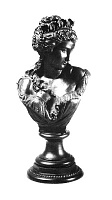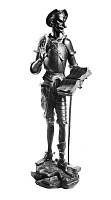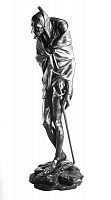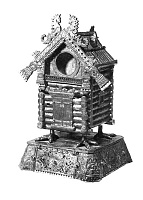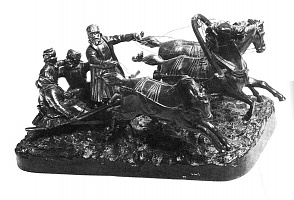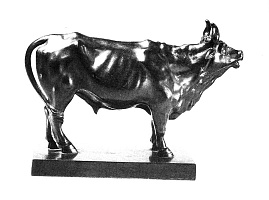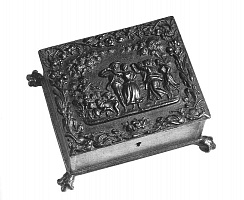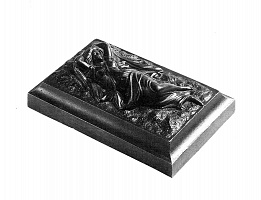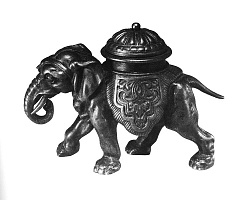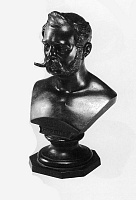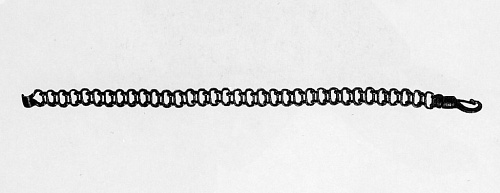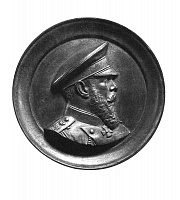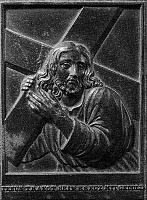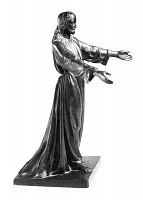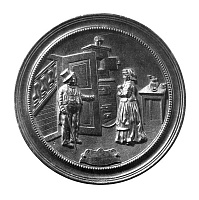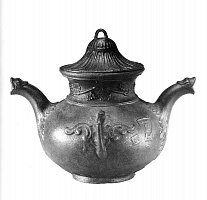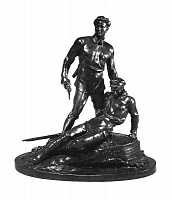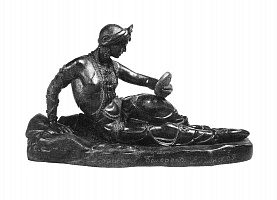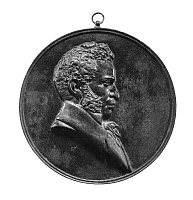Artistic Cast Iron of the 19th – 20th centuries
Cast iron was used in Old Russia for guns, cannonballs and bells. The appearance of interior sculpture is referred by the specialists to the 1820s. In 1860, Kasli cast iron became triumphantly popular in Russia and in European countries. In the 1880s, the works of the other Ural enterprise – the Kusa Plant - gained distinction.
Cast iron ash-trays, paper-weights, figurines, boxes were very popular in the 19th century. They competed with similar articles of marble, bronze and silver. They were placed in living rooms, studies and libraries; they were presented and collected. Figured cast iron was perceived "like bronze" in the 19th century, but it was cheaper and more available. Those were most important factors explaining popularity of iron works. The first masters came to Kasli from Central Russia, then chasers from Zlatoust were invited. In time, there appeared dynasties of figure-casters at those plants. The pure surface of the finished article, the identity to the original depended only on the molder. Every craftsman had his own secrets: sets of tools, ingredients in the molding sand, parting dust, etc. Sculpture demanded special skill. It was molded in parts.
The product line was determined by the fashion, market demands, available molds. The models could be sold by the author, imported from abroad, received from other plants, made by self-taught local sculptors, etc. The most frequent models were bronze works. Cast in raw iron, they acquired new properties. At the beginning they also used German cast iron works as models. The French statuettes influenced the development of cast iron interior sculpture. At the end of the 19th century, Kasli was especially interested in French models in connection with the World Exhibition in Paris, organized in 1900. The works by J. Gauthier (" Quixote" , "Mephistopheles") and animal sculptures, created by P. Mene, were most popular.
The works of Russian sculptors occupied an important place in the cast iron production. In the second half of the 19th century, the characteristic principles of Russian art were "realism, nation, nationality". They were, first of all, manifested in the choice of themes and in their naturalistic representation.
In cast iron the folk themes appeared in statuettes, depicting peasant every-day life, labor and repose: the ink-pot “A peasant on the stump”, statuette “Troika in Winter”, ash-tray “Pot”, clock pedestal “A small hut on the chicken legs” reproducing motifs of architectural wood-carving.
The interest in Russian history and literature is reflected in such statuettes, as “Yermak – conqueror of Siberia” and "Solokha and the Evil One" of 1937.
The iron casters were specially fond of animalistic sculpture. The figures of horses, dogs, deer supplemented vases, boxes, ash-trays or served as individual interior decorations. A Nizhny Tagil craftsman F. Zvezdin is believed to be the founder of the Ural animal genre. His early replica "Bull" was reproduced at the Kasli plant for many years.
P. Clodt, the creator of the famous sculptural groups of horse tamers, decorating St. Petersburg, Naples and Berlin, played a decisive role in the formation of the animalistic genre in Russian plastic art. The reduced copies of these monumental works, as well as other samples, made by the Kasli craftsmen after P. Clodt’s works, were long used as models for artistic cast iron. The works of the famous animal sculptor of the second half of the 19th century N. Lieberich, a pupil of P. Clodt, were also made in cast iron. His works were distinguished by a special interest in details and surroundings, and by clean treatment of the surface.
In Kasli they created casting models; trained molders, chasers, and specialists in techniques of thin-walled casting. There worked local sculptors - M. D. Kanayev and N. R.Bach. In Kusa worked master F.O. Vasenin. Traditionally, the sculptural groups and figurines, as the most laborious and expensive cast iron articles, formed the largest parts in the catalogues.
At the turn of the 20th century, the range of cast iron articles was considerably changed. The circle of genre sculpture was not really expanded, but the production of ashtrays, vases, candlesticks, boxes, etc. increased. These small, figures of animals, birds and people, decorated with reliefs and delicate ornaments, most clearly reflected various stylistic quests of the late 19th - early 20th century.
The molds, included in the product line at the cast iron plants, were reproduced more or less frequently. One and the same mold could be used by different factories. Some articles were memorial.
First of all, there were medallions cast for somebody’s anniversary or in connection with some historical event. Unique exhibition items were created beyond the catalogs. The Kasli watch-chain was one of such singular works.
The church articles were also produced, but only few survived. However, as we know, the icons of cast iron were produced by many factories in the first half of the XIX century. The collection of the Sergiev Posad Museum includes the icon "Mary and Joseph’s Wedding", created at one of the Ural factories at the beginning of the last century. Cast after the Western European model, the icon is characterized by a complicated composition.
Its polychromatic painting is unusual for Russian cast iron of the later period. The medallion "St. John the Evangelist " and statuette "Christ" were cast at the Kasli factory. Foreign cast icons were also spread in Russia. The icon “Carrying the Cross”, from the Trinity- St. Sergius Monastery, was made in the workshop of J. G. Müller.
The Museum collection contains works, made at two small private Nyuvchim and Cherepetsky factories. The Nyuvchim paper-weight, shaped like a massive plate with a bear hurling down on it, is solid and very heavy, which makes it different from similar objects from Kasli and Kusa.
The decorative plates, produced by the Cherepetsky plant, are embellished with genre scenes and relief allegorical figures, framed with cartouches and rich floral sprouts. The models for them were European cast iron works. Most private and state plants produced black and enameled house-hold utensils throughout the 19th century. They were remarkable for simple shapes and lack of ornament. The wash-hand, made at one of the Maltsovs factories, is a rare item in the cast iron collection.
The mass production of artistic iron casting stopped in 1914, when the First World War began. A new period in its history began with the production of works, depicting revolutionary themes in the 1920s. The Sergiev Posad Museum possesses a small group of exhibits, created at the Kasli plant in the 1930s-1950s.
The Kasli pre-war assortment was enriched by E. Janson-Manizer’s statuette "Ballet-dancer Kaminskaya as Zarema " and Vladimir Simonov’s sculptural group "For the power of the Soviet” . In 1937, S. Morgachev made the medallion with the portrait of A.S. Pushkin, that was released for the poet’s anniversary. In the 1930s, the quality of castings was equal to the pre-revolutionary level.
The Kasli castings of the 1950s in the Museum collection are represented, in addition to the manufactured products, by the works of the students of Industrial School № 18, organized at the plant in 1933. Among them is the ashtray “An Oak Leaf”.
The collection of the Sergiev Posad State History and Art Museum-Reserve quite adequately reflects the best period of the Kasli and Kusa activity.
Most items have factory marks, which is important for attribution and identification of some enterprises. A small group of works of the Soviet period illustrate the development of artistic cast iron and present the Kasli castings of the 1930s-1950s.









